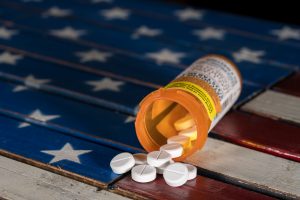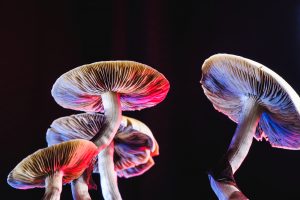Lydia Roberts (not her real name) has suffered from depression and debilitating anxiety for over 25 years, all of her adult life. She had been on and off various antidepressant and anti-anxiety medications but found that most of them had horrible side effects that were just as debilitating as the issue they were trying to treat. When the pandemic hit, her employer transitioned her to a work from home position but after three months she was ultimately let go. Within weeks her mental state deteriorated, she began drinking a little too much every night, and she was having thoughts of suicide. Although she never acted on these thoughts, she knew that she needed help and she needed it fast.
“I was no longer me. I was just a shell of who I once was,” Lydia said. “The depression and anxiety got so bad that I barely left the house. When I did, tremendous anxiety would consume me. I couldn’t breathe, my heart was racing, and I thought that each trip out would be my last. This was no way to live. I didn’t want to go on anymore. I was tired and I just didn’t have it in me anymore.”
A friend suggested ketamine therapy
“I didn’t know what ketamine was so I started to do a little research. What I learned was that ketamine seemed to give people hope, and could even give them their lives back. I was hopeful and intrigued but was terrified that it would work for everyone but me.”
Lydia underwent six ketamine treatments in a three week time frame.
“It was amazing. After the first treatment I was a little tired but was in good spirits, for a change. I finally found a glimpse of hope. When I woke up the next morning, I felt motivated, like really motivated. I hadn’t felt like that in months.”
That was just the beginning. With each subsequent session, Lydia had profound experiences that allowed her to let go of past traumas and move past them. Her depression and anxiety dissipated and she stopped drinking completely (which was one of her intentions). In fact, she no longer felt the need to use antidepressant or anti-anxiety medications. Within eight weeks she was able to titrate down and then stop them completely.
“I felt like during each treatment I was a being reconstructed from the ground up. There were cracks in my foundation. I know that now. So this process was not only beautiful, but life changing. I know that sounds crazy, but it’s the truth.”
Lydia’s case is not an isolated one. Thousands of people have tried ketamine therapy and most have yielded some pretty amazing results. In a time when mental health is declining, people are finding hope and gaining a new lease on life.
A mental health crisis
It’s no secret that before 2020 we were already facing a mental health crisis. And when you add in the events of the last two years, you can see that this crisis has done nothing but worsen. Bereavement, isolation, loss of income, and fear are triggering mental health conditions or exacerbating existing ones in much of the population. Many people are facing increased levels of alcohol and drug use, depression, insomnia, and anxiety.
During the pandemic, about 4 in 10 adults in the U.S. have reported symptoms of anxiety or depressive disorder. This is up from one in ten adults who reported these symptoms from January to June 2019. A Kaiser Family Foundation Health Tracking Poll from July 2020 also found that “many adults are reporting specific negative impacts on their mental health and well-being, such as difficulty sleeping (36%) or eating (32%), increases in alcohol consumption or substance use (12%), and worsening chronic conditions (12%), due to worry and stress over the coronavirus.”
We can talk statistics all day long but the bottom line is that peoples’ mental health as a whole is suffering because of the pandemic. And in a time when antidepressants and antianxiety medications are usually nothing but a band aid at best, people are looking for something, anything to ease their suffering and to feel a sense of normalcy. Enter ketamine.
Although you may not be familiar with ketamine, it has crossed all boundaries and entered mainstream media. Publications such as The New York Times, Vogue, Forbes, and Time have all done stories on this medicine and it is quickly garnering interest from anyone battling anxiety, addiction, depression, PTSD, bipolar, OCD, and even chronic pain. So what exactly is ketamine and what does it do?
Ketamine History and Uses
Ketamine is not a new drug. It is classified as a dissociative anesthetic (dissociative means detached from reality and usual self) and has been approved for use as an anesthetic agent for many years due to its safety.
The "Buddy Drug"
It was first developed by Parke Davis in 1956 and was widely used during Vietnam where it received the nickname, “buddy drug,” because it could be administered by fellow soldiers on the battlefield. It is also on the World Health Organization’s “Model List of Essential Medicines” for its safe anesthetic effect and is commonly used on children because of this.
In the Last 20 Years
It wasn’t until the last 20 years that doctors have started to turn an eye to ketamine for mental health. They started to notice that it could reverse depression within hours, and researchers regarded it as a “medical breakthrough that hasn’t been seen in over 50 years.” This was a far cry from traditional antidepressants that can take several weeks to possibly see results. Ketamine also made its way around the recreational drug scene through the years. Typically a “bar” drug, it was not uncommon to find people snorting it in bathrooms. However, it is interesting to note that many recreational ketamine users reported mood improvement following casual use.
Off-Label Use
What makes ketamine a viable treatment option?
It all comes down to science, as usual. Researchers haven’t uncovered everything about this drug yet, even after working with it in different capacities over the years, but there are new studies and we are learning more about it daily. However, this is what we do know…
The science of ketamine
Ketamine affects the glutamate system (the brain uses glutamate for neurons to communicate). At high doses, it seems to block glutamate, making it an effective anesthetic. Low doses increase glutamate production, which is where the antidepressant effects come into play.
Ketamine is also classified as an NMDA (N-methyl-D- aspartate) antagonist, meaning that it blocks the NMDA receptor from reabsorbing glutamate and causes the release of BDNF (brain-derived neurotrophic factor).
BDNF is an important brain chemical. It is responsible for the maturation and maintenance of the cell dendrites and synapses that are necessary for normal healthy brain connectivity. Stress and anxiety inhibit the production of BDNF leading to visible changes in neurophysiology and subsequent serious mood disorders such as depression, PTSD, anxiety, addiction, and OCD. Not only does ketamine increase BDNF, but it also increases the number of receptors that BDNF binds to. Over time, more repair factor and more receptors are available for activation by the repair factor. The outcome is that over a period of weeks, neuroplasticity and repair can occur in the brain.
Administration
There are several ways to administer ketamine, including intravenous infusion (IV), intramuscular injection (IM), intranasally, orally, and sublingually (as a dissolving troche or lozenge). Each route varies in the onset of action (time), bioavailability (absorption), and clearing time, and also varies for each person. Although a response is generally predictable based on past administration, it is possible that a patient may experience different physiological, psychological, and emotional effects with the same dose. Now that we got all of the sciencey stuff covered, let’s look at the effects of ketamine and how it can be a complete game-changer.
Effects: What does ketamine feel like?
The effects of ketamine can range from very subtle, like having a glass of wine and feeling mild sub-perceptual disturbances to very profound where one feels separate from the body and thoughts completely dissolve (dissociative psychedelic experience). Every experience is different for each person depending on tolerance, dose, mood, etc. Current research has shown that some level of dissociation can be more beneficial for a positive treatment response.
These feelings are “non-ordinary states of consciousness” and may result in profound, and even life changing, experiences for some people. This departure from the usual mental and physical state can sometimes be challenging. However, the treatment environment, supportive staff, dosing protocol, and proper integration can optimize the overall ketamine experience.
Combining ketamine with psychotherapy can yield a greater response than ketamine treatments alone. The altered states of consciousness of the ketamine experience provides valuable material to work with in therapy sessions either during a low dose treatment or following ketamine sessions.
Are there any side effects?
The most common side effects are fatigue, dizziness, nausea, and/ or vomiting but is treated with an anti-emetic such as Zofran. Other side effects may include hallucinations, euphoria, perceptual disturbances, confusion, changes in heartrate, changes in blood pressure, anxiety, itching, increased saliva production, change in motor skills, musculoskeletal disruptions, rash, and double vision. However, most of these are very rare.
Are you a good candidate for ketamine?
Usually ketamine is not a first-line treatment for depression, mood disorders, or pain, and is mostly used after other unsuccessful treatments. However, this is not always the case. A psychiatrist will assess if ketamine is a good treatment option for you. Before participating in a ketamine treatment, you will be carefully screened to determine if you are eligible for ketamine therapy. This includes medical history, physical exam, review of other treatments, psychological assessments, and a psychiatric evaluation.
Most people are able to receive ketamine treatments but some patients may not be eligible depending on certain conditions. These include history of psychosis or increased intracranial pressure, pregnant or nursing, uncontrolled hypertension, acute or unstable cardiovascular disease, or a previous negative response to ketamine.
What to look for when choosing a ketamine facility
There are several factors to consider when selecting a ketamine facility.
Cost
Treatment packages can range from $3,000-$4,000 at ketamine clinics and are not usually covered by health insurance. At home ketamine facilities are substantially less expensive and hover around $1,500. There are pros and cons for each.
Dosage
Some clinics keep the dosing low and do not give patients psychedelic experiences. Although the medicine still gets into the brain, having a profound experience can have a synergistic effect.
Comfort
The biggest complaint I have heard about ketamine clinics is that some of them tend to push a patient out the door right after a treatment. There is something to be said about having the ability to conduct your ketamine sessions in the comfort of your own home. Sometimes people find it difficult to “let go” when they are in an unfamiliar setting (and especially in a medical clinic setting). However, others feel “safer” in a clinic. Essentially, it is up to you.
Integration
If the facility is administering psychedelic doses, are they helping to integrate the experience afterwards? If not, find one that does.





